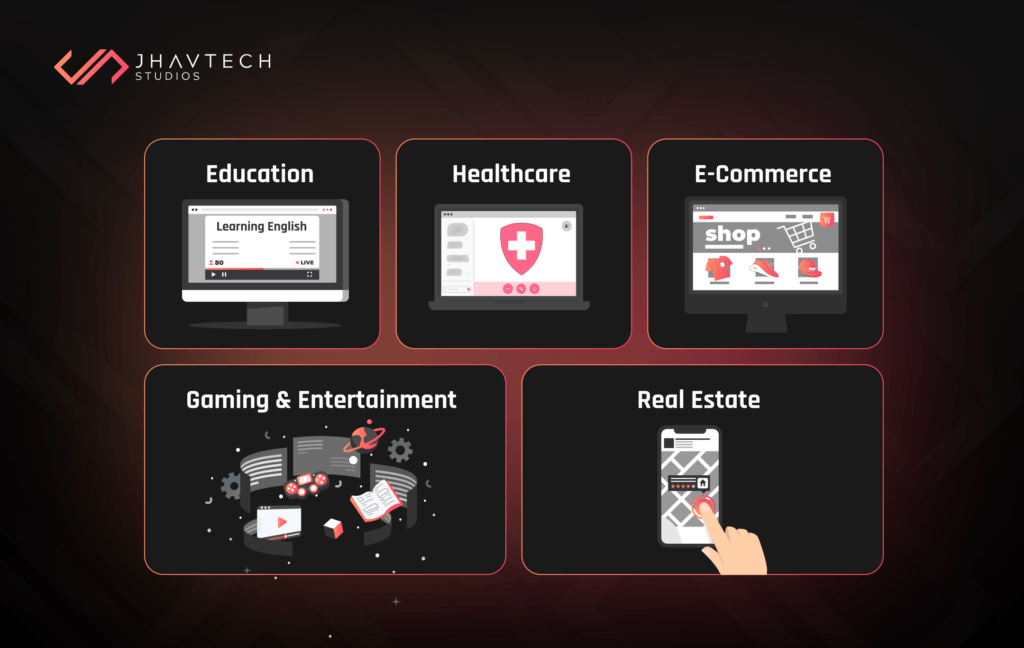App Development for the Metaverse in 2025: Creating Immersive Experiences

The metaverse, a virtual universe that intertwines the digital and physical worlds, is no longer a concept of the future. With advancements in technology and growing interest from tech giants like Meta, Microsoft, and Apple, the metaverse is rapidly becoming a reality. For developers and businesses, this emerging frontier offers opportunities to create groundbreaking applications that redefine interaction, commerce, and entertainment.
This blog explores the nuances of app development in the metaverse, the tools required, and real-world examples to illustrate how developers can create immersive experiences.
Understanding the Metaverse
The metaverse is essentially a shared virtual space that blends augmented reality (AR), virtual reality (VR), and other digital technologies. It offers users an immersive environment to socialise, work, shop, and play. According to a report by Fortune Business Insights, the global metaverse market size is projected to grow from $63.83 billion in 2022 to $936.57 billion by 2030, showcasing its potential for app developers.
Key components of the metaverse include
3D Environments
These spaces are richly detailed and interactive, enabling users to explore virtual worlds that feel tangible and engaging. Developers must ensure these environments are optimised for seamless interaction and scalability.
Interoperability
The ability to transition seamlessly between different metaverse platforms is essential for user retention and satisfaction. This requires collaboration between developers and adherence to emerging standards.
Persistent Worlds
Virtual spaces continue to exist and evolve even when users are offline, requiring developers to integrate cloud technologies and ensure real-time updates without disrupting user experiences.
Social Presence
Enhanced communication through lifelike avatars, gestures, and real-time interactions creates a sense of community, adding a layer of realism and connection.
Tools for Metaverse App Development
Developing applications for the metaverse requires specialised tools and platforms. Here are some of the most popular ones:
1. Unity and Unreal Engine
These are industry-leading engines for creating 3D experiences. Unity is favored for its versatility and compatibility with AR/VR devices, while Unreal Engine excels in delivering photorealistic graphics. Developers can leverage these platforms to build immersive and engaging applications.
Example: The popular VR game Beat Saber was developed using Unity, demonstrating how the engine supports dynamic and interactive environments. Unreal Engine, on the other hand, powers Fortnite, showcasing its capability to create massive, visually stunning virtual worlds.
2. ARKit and ARCore
Apple’s ARKit and Google’s ARCore enable developers to create AR experiences for iOS and Android, respectively. These tools provide features like motion tracking, environmental understanding, and light estimation, making it easier to merge digital elements with the real world.
Example: IKEA’s Place app uses ARKit to allow users to visualise furniture in their homes. This approach bridges the gap between virtual and real-world experiences and simplifies decision-making for customers.
3. Blockchain Technology
Blockchain ensures secure ownership and transactions of digital assets within the metaverse. Platforms like Ethereum and Solana provide frameworks for developing decentralised applications (dApps).
Example: Decentraland uses blockchain to empower users to buy, sell, and build on virtual land, providing a decentralised model for ownership and economic activities.
4. AI and Machine Learning
AI technologies enhance user interaction by enabling intelligent NPCs (non-player characters) and adaptive environments. They also facilitate personalised experiences within the metaverse.
Example: Roblox incorporates AI to dynamically generate content and suggest personalised game experiences for users, ensuring each session feels unique and engaging.

Strategies for Creating Immersive Experiences
1. Focus on User-Centric Design
The user experience (UX) should be at the core of app development. Intuitive navigation, realistic graphics, and responsive controls are crucial for immersing users in the virtual world. Developers should conduct user testing to gather feedback and refine their applications accordingly
Example: Meta’s Horizon Worlds prioritises social interactions by providing users with tools to create and share their own virtual experiences, fostering creativity and collaboration.
2. Leverage Gamification
ncorporating elements of gamification, such as rewards, challenges, and leaderboards, can enhance user engagement. These features motivate users to explore and interact more deeply with the virtual environment.
3. Utilise Real-Time Collaboration Tools
Applications that facilitate real-time collaboration and communication are in high demand. These tools are particularly useful for remote work, virtual events, and multiplayer gaming. Adding features like synchronised editing, voice communication, and shared workspaces can significantly enhance functionality.
Example: Microsoft Mesh enables teams to collaborate in shared 3D spaces, enhancing productivity and creativity by bridging the gap between physical and digital collaboration.
4. Enhance Accessibility
App developers should ensure their applications are accessible to users with disabilities. Features like voice commands, adjustable controls, and visual enhancements can make a significant difference in user inclusivity.
5. Incorporate Real-World Integration
Linking the metaverse with the real world through IoT devices or AR applications can provide users with a seamless experience. Developers should explore innovative ways to integrate physical and digital touchpoints.
Example: Pokemon GO integrates AR with real-world locations, creating a captivating blend of physical and virtual realities that keeps users engaged.
Real-World Applications of Metaverse App Development
1. Education
Virtual classrooms and training simulations are revolutionising education. Apps like Engage VR allow students to participate in interactive lessons and collaborative projects, making learning more engaging and effective.
2. Healthcare
The metaverse is transforming healthcare through virtual consultations and training simulations for medical professionals. For instance, AccuVein uses AR to visualise veins, improving the accuracy of injections and reducing patient discomfort.
3. E-Commerce
Brands are leveraging the metaverse to provide virtual shopping experiences. Platforms like Obsess create VR-based showrooms, allowing customers to browse and purchase products in an immersive environment. Adding interactive elements like virtual try-ons further enhances the shopping experience.
4. Gaming and Entertainment
Gaming remains one of the most significant drivers of the metaverse. Popular games like Fortnite and Minecraft have evolved into social hubs, hosting virtual concerts and events. Developers should focus on creating engaging storylines and dynamic gameplay to captivate users.
5. Real Estate
Virtual property tours enable potential buyers to explore properties without physical visits. Companies like Matterport are at the forefront of creating digital twins for real estate, offering an innovative way to market properties and interact with clients.

Future Trends in Metaverse App Development
The future of app development in the metaverse is exciting and filled with innovation. Here are some trends to watch:
1. Hyper-Realistic Avatars
As technology advances, avatars will become more lifelike, enhancing social interactions within the metaverse. Developers should focus on enabling customisation and expressive capabilities to improve user identity representation.
2. Haptic Feedback
Devices that provide physical sensations will make virtual interactions feel more real. This technology can elevate gaming, virtual shopping, and training simulations, offering users a more tactile experience.
3. Decentralised Economies
Blockchain-based economies will continue to grow, enabling users to trade virtual assets securely. Developers should explore integrating cryptocurrencies and NFTs to enhance transactional capabilities within their applications.
4. Sustainability Initiatives
With the energy demands of metaverse applications, developers will focus on creating sustainable and energy-efficient solutions. Utilising green hosting services and optimising resource usage can help mitigate environmental impacts.
5. Cross-Platform Integration
The ability to move seamlessly across devices and platforms will become a standard expectation for users. Developers must prioritise compatibility to ensure that applications can deliver consistent experiences regardless of the user’s hardware or operating system.
Final Thoughts…
The metaverse is more than a trend; it’s a paradigm shift in how we interact with technology and each other. For developers, app development for the metaverse presents a thrilling opportunity to shape the future of digital experiences. By leveraging advanced tools, prioritising user experience, and addressing development challenges proactively, developers can create applications that captivate and inspire.
Whether it’s virtual education, immersive gaming, or next-gen social platforms, the possibilities are endless. The metaverse is here, and now is the time to innovate and build experiences that redefine reality.
.svg)

